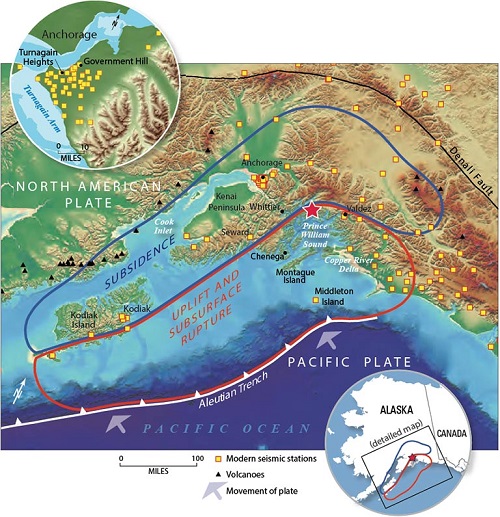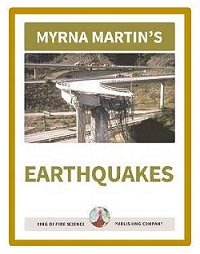Moment magnitude scale
Measuring Great earthquakes
Moment magnitude scale
The moment magnitude scale (MMS) was devised by scientists after the 1960 Chilean earthquake and the 1964 Alaskan earthquake. These great subduction zone earthquakes broke along fault lines that were hundred of kilometers long.
Measuring the entire earthquake
The moment magnitude scale in determining an earthquake's magnitude takes in "the entire moment" of the earthquake. The moment magnitude scale developed in recent years avoids the problem of gathering information from only one type of ground motion and not looking at all aspects of an earthquake.
The Richter scale
The Richter scale did not adequately show the magnitude and size of what happened during these two great earthquakes because it only measures the height of largest wave recorded on a seismogram to determine the magnitude of the earthquake. The Richter scale is an open-ended scale that becomes saturated when earthquakes near 9.0.
Total energy released by an earthquake
The moment magnitude scale avoids many of the problems of these earlier scales. The moment of an earthquake is a physical quantity related to the total energy released during the earthquake.

Map of the 1964 Great Alaska Earthquake USGS
What the moment magnitude measures
Measuring fault rupture and slippage
The moment magnitude includes the area of the fault rupture and slippage along the fault. It also includes the size of the seismic waves recorded on seismograms by seismographs. Formerly the United States Geological Survey used the Richter Scale when describing an earthquake's magnitude.
when do scientists use the different scales
Measuring moderate to large earthquakes
Today the moment magnitude scale supersedes other scales and is used to estimate the magnitudes for all moderate to large earthquakes. Other scales including the Richter scale are used for earthquakes less than 3.5 magnitude. The majority of earthquakes felt worldwide are less than 3.5 magnitude.
Richter scale
The reason the Richter scale was so popular with news agencies is the speed the news could be spread to people on radio and television broadcasts. Seismographs near the epicenter were used to determine the largest seismic wave and the news was quickly reported to radio and television stations within hours of the earthquake. The moment magnitude scale takes a much long time period to determine the size of the earthquake.
Comparing magnitudes of the two scales
After the 1960 Chile earthquake the Richter scale registered the earthquake size at magnitude 8.5. Scientists using the moment magnitude scale revised the earthquakes size up to magnitude 9.5. This is the largest earthquake ever recorded since seismographs were invented.


Click for More Information and to Order
Comparing Magnitudes of Four other large earthquakes
- New Madrid, MO 1812 - Richter scale 8.7 -- moment magnitude scale 8.1
- San Francisco, CA 1906 - Richter scale 8.3 -- moment magnitude scale 7.7
- Prince William, AK 1964 - Richter scale 8.4 -- moment magnitude scale 9.2
- Northridge, CA 1994 - Richter scale 6.4 -- moment magnitude scale 6.7
KIDS FUN Science Bookstore
Check out Myrna Martin's award winning textbooks, e-books, videos and rock sets. The Kids Fun Science Bookstore covers a wide range of earth science topics. Click here to browse.










